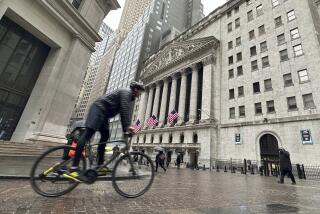Dow jumps 421 points, buoyed by Fed’s interest rate stance
Wall Street capped a worldwide rally in stocks as investors signaled their approval of the Federal Reserve’s go-slow approach on raising its rock-bottom benchmark interest rate — even in the face of still-falling crude oil prices.
The Dow Jones industrial average of blue-chip stocks rose 421.28 points Thursday, its biggest single-day jump in three years and the 13th largest ever. The 2.4% gain left the key index at 17,778.15 and wiped out days of triple-digit losses over the past week.
Last Friday, the Dow closed with its worst week in three years as investors fretted over a seeming free-fall in oil prices, a weakening Russian economy and unease about when and how fast the Fed would start to raise rates.
But Fed Chairwoman Janet L. Yellen put Wall Street at ease Wednesday after Fed policymakers ended a regular two-day meeting by clarifying the group’s written policy statement, noting that the central bank would be “patient” in raising rates over three years and that Russia’s woes shouldn’t affect the U.S. much.
“Janet Yellen played the role of a beneficent Santa Claus,” said John Lonski, chief capital markets economist for Moody’s Analytics. “The policy statement was written in a manner that market participants could see what they wanted to see and disregard the rest.”
Broader indexes also rallied Thursday, greatly extending the gains that began after Yellen’s news conference Wednesday afternoon. The Standard & Poor’s 500 index rose 48.34 points, or 2.4%, to 2,061.23. The tech-heavy Nasdaq composite index rose 104.09, or 2.2%, to 4748.40.
Thursday’s gains indicated that the sell-off was overdone, Lonski said, and that the more obvious benefits of falling oil prices — a boon to the rest of the economy and consumers in particular — would add more fuel to a healing U.S. economy.
Indeed, analysts have noted that the falling oil prices will work to keep inflation figures down, lending the Fed even more flexibility in keeping rates low and giving consumers continued access to cheap credit card and mortgage rates.
On Thursday, mortgage rates hit a fresh low for the year. The average for a 30-year fixed loan fell to 3.80% this week, down from 3.93% a week earlier, according to mortgage finance company Freddie Mac.
Lonski said analysts will be keeping an eye on whether falling oil prices spread to other basic commodities — copper, aluminum, zinc — a sign of a global slowdown that could threaten the U.S. recovery.
He said the Fed is likely to remain cautious until the price of oil stabilizes and the risk of global deflation recedes.
The U.S. rally followed an even bigger surge in some European markets, with France’s CAC 40 jumping 3.4% and Germany’s DAX up 2.8%. The British FTSE 100 index, though, inched up less than 0.1%.
Stocks had been roiled in the past week as dramatically falling oil prices were seen as both a reflection of slowing global growth and an aggravating factor, especially for Russia, a major European trading partner that is grappling with twin crises of a falling currency and an economic downturn.
Investors also were concerned that if oil kept up its free-fall, problems in the U.S. energy sector, which accounts for about 13% of corporate earnings, would spread to the rest of the economy, starting with lenders holding the debt of fragile and deeply indebted newer oil-shale exploration companies.
The Fed’s stance was enough for the markets to shrug off oil’s continuing plunge. The spot price for West Texas Intermediate crude fell 4.2%, or $2.36, to $54.11 Thursday, while Brent crude fell $1.20, or 2%, to $60.01.
In a recent note, Moody’s Chris Lafakis calculated that the fall in oil prices, even taking into account cutbacks on investment in the oil sector, would by itself add 0.4% to U.S. economic output in the fourth quarter.
“Falling oil prices are unmistakably a positive for the U.S. economy,” he wrote.







